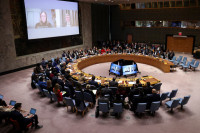Opinion
New wars, new solutions
As the nature of global conflict changes, modern resolution models are required.
Bishnu Raj Upreti
Conflict is a cognitive and psychological process based on the stimulus-response theory. It is inevitable and an integral part of society and an indicator of change. Major causes of conflict in the 21st century are competition over scarce resources, power and position; ambiguity over authority and responsibility; differences in perceptions, work styles, attitudes and experiences; divergent philosophies; lack of understanding of social processes; resistance to socio-political and technological changes; encroachment and interference of global power; advancement of sciences and technologies; development of chemical and biological weapons; globalisation and privatisation of public services; and growing consumerism.
International interests play a crucial role in conflict, and these are often embedded under political, security, strategic and economic supports. Environmental stress, natural calamities and climate change, water scarcity, food insecurity, mass migration and epidemics are contributors of future conflict.
The 21st century encounters a different nature and scale of conflict. In the past, high scale wars were common. This will change to more invisible, fuzzy and decentralised tensions in this century with low to high intensity and coverage. In the 21st century, the developed countries are facing growing insecurity compared to the 20th century. High risk perception, deep suspicion and more tactical relations are the new characteristics of powerful countries. Below are some facets of future conflict.
International borders and territories are important facets of future conflict. Some examples of this facet are the determination of US president Donald J. Trump to erect a wall on the US-Mexico border, perennial tensions between India and Pakistan, between Israel and Palestine, and on the Korean peninsula. Economics will be an important source of future tensions.
A growing feeling of injustice in the developing world against the most developed nations for their winner-take-all approach is a flashpoint for conflict. When African nations were facing an unprecedented HIV/AIDS crisis, the developed countries were developing expensive medicines to sell to the affected. Trade tensions of the US with Europe, China, Latin America and many other countries will be another source of periodic tension.
Intolerance, extremism and far-right radicalism are growing not only in the developing countries but also, and more quickly, in the developed world. Radicalised discourses of ethnic identity, indigenous (prior) rights and religious radicalisation are growing. Pervasive structural inequalities, bad governance, discrimination, nepotism and red-tapism are major facets. The interests of powerful nations are reflected in their political, security and economic cooperation. The countries giving political, security and economic support are not doing it for free. These supports are strongly embedded with vested interests.
Regarding environmental and natural resources aspects, disasters, environmental and climate insecurities, energy scarcity, scarcity water, land grabbing, tensions in coastal resources will be at the heart of future intra- and inter-state tensions. The lack of ability of mega cities to accommodate the livelihood needs of migrants and slum dwellers could be a catalyst for conflict. One billion people (one-sixth of the world’s population) live in slums with very low-paid jobs, and unemployment forces them to engage in begging, prostitution and urban crime and violence.
Demographic dynamics are unexpectedly changing in the 21st century. The world’s population was 1.6 billion at the beginning of the 20th century, and it will reach 8 billion by 2030. It is also expected to cross over 9 billion in 2050. India’s population will reach 1.6 billion by 2050. A dramatic rise in population growth rates in Bangladesh, Egypt, Indonesia, Nigeria, Pakistan and Turkey, and negative growth in the developed countries will completely change the current demographic landscape and become a source of conflict.
The epidemic facet is the most ignored facet by political decision makers. The world has already encountered the Zika virus, severe acute respiratory syndrome, Ebola and HIV/AIDS, which have demonstrated their disastrous effects. In the future too, the emergence and spread of new epidemics is likely. The development of nuclear weapons, weapons of mass destruction and earth-penetrating missiles, space competition, and the development of biological and chemical weapons are other facets of 21st century conflict.
While dominant global structures like the United Nations Security Council, World Bank and European Union are either being questioned for their performance or facing enormous internal challenges, new global structures such as BRICS (Brazil, Russia, India, China, South Africa) and regional structures like the Asian Infrastructure Investment Bank are emerging as alternatives. The existing powerful international agencies have their neo-liberal competitive orientation which is not suitable for the weak and poor and, therefore, they are becoming less relevant.
Together with a rapid change in the existing world order, the cause, nature and facets of conflict are also changing. The dominant forms and patterns of conflict observed in the 20th century will not be repeated in the 21st century; and the world will face new causes, spectrums and facets of conflict. Therefore, the existing dominant model of conflict management and resolution models will be less relevant and ineffective in the changing context of shifting power.
Upreti holds a PhD in conflict management




 6.81°C Kathmandu
6.81°C Kathmandu












